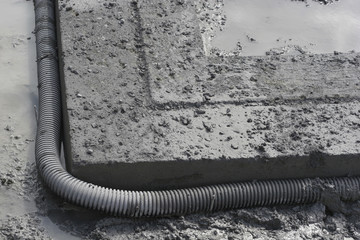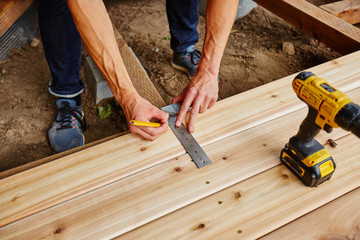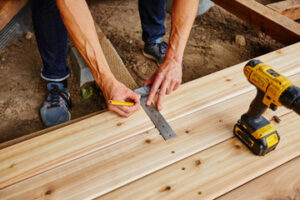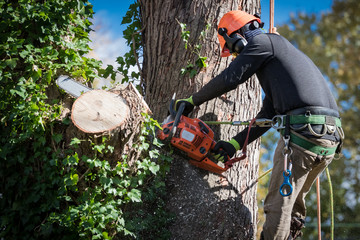French Drain Baltimore oftens solve problems like wet basements, soggy yards, and foundation issues. They can be tricky to DIY, so working with a pro is the best action.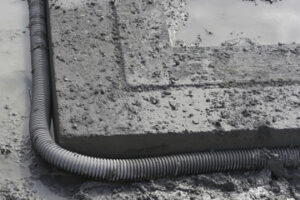
A French drain comprises a sunken channel, perforated pipe, and gravel. The drainage system is usually wrapped in a water-permeable fabric, which prevents dirt, weeds, and other debris from clogging the pipes over time.
A French Drain is a landscaping solution that redirects excess water to a safe exit point, preventing water damage and soil erosion. It is low-maintenance and long-lasting, and it’s customizable to fit the unique needs of a property.
The process of installing a French Drain begins by identifying the problem area and planning a drainage route to ensure water is channeled away effectively. Once the drainage route is determined, a trench is dug that’s the appropriate size and depth for the drain. The trench should slope downhill or toward a discharge point to avoid pooling and blockage of the drain. Once the trench is excavated, a layer of gravel is added and the perforated pipe is placed in the middle of it. The trench is then lined with non-woven geotextile filter fabric to protect the drain from dirt and debris that can clog it over time.
Once the drain is in place, the remaining gravel is added to cover the pipe and prevent soil erosion over time. Then, the landscape fabric is folded over the top to create a barrier between the gravel and the soil above it. The pipe and the gravel are then covered with a layer of topsoil that matches the surrounding yard, restoring the appearance of the landscape and blending it into the home’s exterior.
One of the primary benefits of a French Drain is that it eliminates standing water, which can be a breeding ground for mosquitoes and other pests. Additionally, French Drains can be integrated into rainwater harvesting systems, allowing homeowners to collect and use water for irrigation purposes.
Stagnant water is also a breeding ground for erosion and soil damage, as it washes away topsoil and damages plant roots. This can lead to the deterioration of foundations and other landscaping features, and it’s essential to prevent this type of water damage by installing a French Drain.
A French Drain can effectively manage the flow of excess water throughout your property and keep it healthy for landscaping, reducing maintenance and boosting curb appeal. It is easy to install, and it can be tailored to the specific needs of your yard. It’s a smart investment that helps prevent water damage to your home and yard, and it can even increase your property value by demonstrating a proactive approach to landscaping and water management.
Prevents Water Damage to a Home’s Foundation
Water damage to your home’s foundation is one of the worst problems you can face as a homeowner. If left unchecked, it can weaken the structure and cause structural issues that lead to costly repairs or even a full foundation replacement. However, if you take the steps to keep moisture away from your property’s foundation, it can prevent the damage before it occurs and extend the lifespan of your home’s structural materials.
French Drains prevent water damage by redirecting groundwater away from your home’s foundation. The system uses a gravel-filled trench around the house’s perimeter and a perforated pipe that collects the groundwater. It’s often covered with a filter fabric that prevents soil and debris from clogging the pipe.
Once the French Drain has collected the water, it’s directed toward a sump pump. The pump then pumps the water away from your property, keeping the area dry and preventing hydrostatic pressure that can put a strain on your foundation walls.
A properly installed French drain also helps prevent moisture from damaging your foundation’s concrete, wood and other building materials. Sustained exposure to moisture can result in a variety of problems, including cracking, warping, rotting, and deterioration. Providing a barrier that diverts moisture from the foundation can protect these materials and extend their lifespan, saving homeowners money on repair or replacement costs.
To make sure the French Drain is as effective as possible, it must be correctly positioned to divert groundwater from the foundation. It’s important to dig the trench so that it slopes downward in all areas, especially in low sections of the yard where the water will pool most frequently.
In addition to preventing water damage, French Drains can help keep your home’s foundation healthy by improving the air quality in basements and crawl spaces. Moisture and humidity in these spaces can be breeding grounds for mold and mildew, which are known to cause health problems for occupants. By keeping basements and crawl spaces as dry as possible, French Drains can indirectly help improve indoor air quality by eliminating these allergens.
Controls Erosion
A French drain redirects water flow, preventing excess moisture from pooling around a home or business foundation. This significantly reduces the risk of structural damage and mold growth as well as protects the integrity of landscaping elements like lawns, gardens, and shrubbery.
It also helps to prevent soil erosion, which is a common problem in yards with slopes that are too steep or with little vegetation to anchor the topsoil. Erosion can damage these landscape elements, removing nutrients from them, and in severe cases can destabilize or even crack the foundation of a home or building. A French drain reduces erosion by allowing the excess water to seep through it and into a drainage system instead of eroding the ground beneath it.
The drainage system can be installed in a variety of ways, depending on the specific needs of the property. In general, it’s recommended that the drain be positioned within the lower part of a garden or yard, to minimize the disruption of the landscape and the appearance of the home.
Since water naturally seeks the path of least resistance, it will typically move downward in a garden or yard. However, if the area is poorly drained or has slopes that are too steep, it can be more likely for water to collect against sunken walls or in other barriers that can erode and weaken them over time.
The drainage system is designed to prevent this, by directing the water into the drain instead of against these walls. To ensure this happens, the trench is filled with a layer of gravel that is larger in the center and gradually gets smaller toward the edges to slow down the water and prevent it from clogging.
To further minimize the potential for clogging, the drain can be fitted with multiple underground pipes. Adding redundancy is especially useful if the area where the drain is located receives a lot of rainfall or runoff from other sources. Another option is to direct the excess water into a rain garden, which acts as a natural filtration system for rainfall and runoff by filtering out harmful chemicals and pollutants through the roots of plants.
Maintains a Healthy Yard
Whether you’re looking to protect your home’s foundation, prevent erosion or elevate the look of your lawn, installing a French drain can be a rewarding project. Just make sure to consult a professional landscaper for proper installation and maintenance to ensure your drainage system works correctly.
A French drain is made up of a sloped trench filled with gravel and perforated pipe designed to funnel water away from areas of your yard where standing or pooling occurs. The pipe is wrapped in a water-permeable fabric to prevent weeds, dirt and other debris from obstructing the drain. The gravel surrounding the pipe is used to cover and conceal the pipe, and it’s a good idea to add some rounded rocks to the trench to provide a more natural look for your landscape.
One of the most common signs you have drainage problems in your yard is puddles that remain on the ground the day after a rainstorm. Standing water not only causes muddy footprints, but it also prevents grass and plants from growing. In addition, accumulated moisture can wreak havoc on your house’s foundation and basement, lead to termite infestations, encourage mold growth and other unwanted consequences. A French drain can keep moisture at bay, helping your lawn and garden grow lush and healthy.
In addition to preventing flooding and water damage to your home’s foundation and structure, drainage systems can also improve soil quality. When excess water lingers on your property, it can cause compaction and reduce the amount of oxygen in the soil. A French drain can redirect excess water to a more appropriate location, protecting your soil and allowing it to be healthy again.
The best way to maintain your French drain is by regularly clearing out mud and debris that may build up. It’s also a good idea to have a pro inspect and snake the drains every year or so to make sure they are still functioning properly. If you’re interested in having a French drain installed in your yard, contact us today for a free quote. We also offer landscaping services, including mowing, seasonal cleanups, mulching and more.
